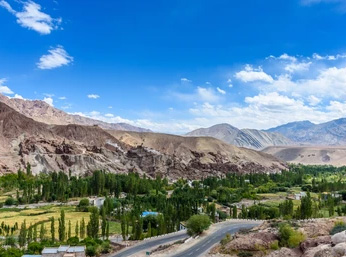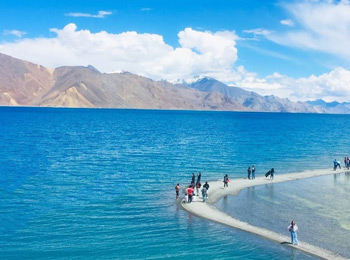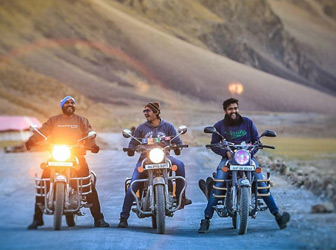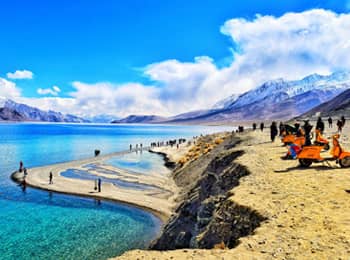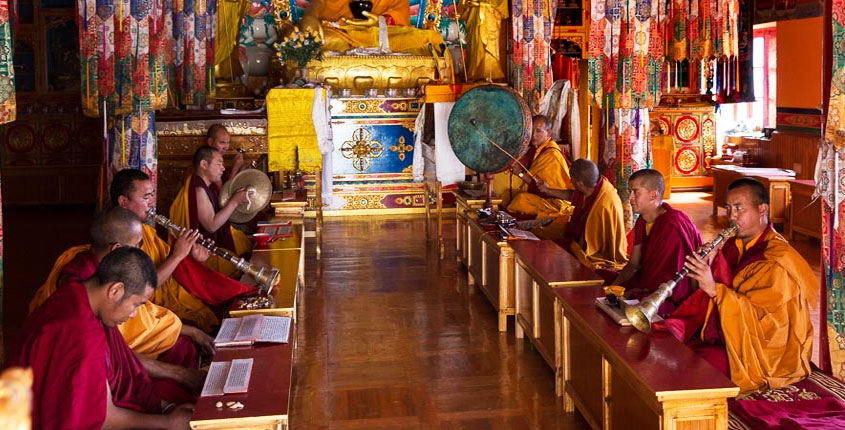
Buddhism in Ladakh
![]()
Buddhism in Ladakh, deeply influenced by Tibetan Buddhism, particularly the Mahayana and Vajrayana schools, is a treasure trove of ancient culture. This rich heritage, a popular theme for cultural tours in Ladakh, is a testament to the spiritual and cultural richness of the region. In these forms of Buddhism, Buddha is worshipped as a deity who has attained Nirvana (freedom from the cycle of birth and death). Various incarnations of Buddha, known as Bodhisattvas, are also worshipped in monasteries. Many tourists visit Ladakh to explore, understand, and learn from this profound and ancient Buddhism.
The mythology of Tibetan Buddhism includes many tales of various spirits and demons. These representations of both good and evil qualities are depicted in masks, and their stories are enacted as masked dances during the annual festivals of various Gompas in Ladakh.
For a seamless and enriching experience, Leh Ladakh India offers expert-guided tours. These ensure a hassle-free trip where every detail is meticulously taken care of. Customize your tour with them and let their professionals handle everything so you can fully immerse yourself in the spiritual and cultural wonders of Ladakh.
Dalai Lama: The Buddhists of Ladakh regard His Holiness the Dalai Lama as their supreme spiritual leader and as the living incarnation of Buddha. The present Dalai Lama, the 14 Dalai Lama, was initially known as Tenzin Gyatso. As a child, he was recognized as an incarnation of the previous Dalai Lama, who had passed away in 1933. Tenzing Gyatso was brought to Lhasa and proclaimed the new spiritual leader of the Tibetan people on Feb 22nd, 1940.
Due to his resistance to the Chinese occupation of Tibet, the Dalai Lama became an icon of political and spiritual leadership for the Tibetans. The Dalai Lama left Tibet and came to India in March 1959. Ever since he has led an international campaign against the Chinese occupation of Tibet. He received the Nobel Prize for Peace in 1989 for his leadership in the struggle for the peaceful liberation of Tibet.
Some Common Buddhist Terms are:
Gompas: A Gompa is a spiritual community where monks or nuns live and practice their religion. Gompas in Ladakh are also educational institutions and play a central role in the life and economy of the local community. Gompas are more than just monasteries, and many have museums where tourists can view collections of Buddhist art. The annual festivals in Ladakh are celebrated at the Gompas, which are a colorful sight with masked dances and religious ceremonies drawing both pilgrims and tourists in large numbers.
Chortens and Stupas: Chortens and stupas are dome-shaped structures built over a square base. They are usually built in memory of a Buddhist monk or religious teacher. Some stupas may contain relics of holy men. Chortens are often decorated with Buddhist prayer flags, and offerings such as oil lamps or flowers may be placed around them.
Thangka: Thangkas are not just Buddhist religious paintings that depict episodes from the life of Buddha or various Bodhisattvas. They are rich in symbolism and Buddhist imagery, making them fascinating religious artifacts. The art of learning to paint a Thangka requires extensive training, adding to their mystique and allure.
Mandala: According to Buddhist iconography, a Mandala is a symbolic representation of the Universe. A colorful design made from sand on the floor of a monastery or painted on a wall or screen, a mandala is believed to have mystical powers that aid in meditation, concentration, and prayer. Mandalas often depict a palace with four gates, which open to the four principal directions of the Earth. Mandalas are used in the rituals of a monk's initiation and are called the 'Architecture of Enlightenment' Mandalas made of sand are usually swept away after a prayer ceremony to symbolize the impermanence of life. The designs of the Mandala follow an ancient tradition and consist of concentric circles and intersecting lines. The process of learning to create a Mandala is part of the training of every Tibetan monk.
Central Institute of Buddhist Studies
The Central Institute of Buddhist Studies in Ladakh is the premier institution for studying Buddhism in Ladakh. Established in 1959, the institute was created by the combined effort of ten important Gompas of Ladakh. Pandit Jawahar Lal Nehru, India's first Prime Minister, extended the support of the Indian Government to this institute of learning. The Institute currently offers courses from primary education to Doctoral Degrees and has 29 Gompas and nunneries affiliated. The Central Institute of Buddhist Studies plays a crucial role in preserving and promoting the rich Buddhist heritage of Ladakh. It is located in Choglamsar, about 8 kilometers from Leh.
- Passes
- Lakes
- Monasteries
- Attractions
- How to Prepare for Ladakh Trip
- Facilities in Ladakh
- Climate
- Family Trip to Ladakh
- How and Where to Carry Spare Fuel
- Ladakh With Parents - Senior Citizens
- How to Carry Laptop
- ATM and Bank Facilities in Leh City
- Things to Carry for Ladakh Winter Trip
- Where & How to Rent an Oxygen Cylinder
- Ladakh in June
- Ladakh in May
- Ladakh in July
- Ladakh in September
- Ladakh in October
- Ladakh in August
- Ladakh in November
- Leh to Nubra Valley
- Delhi to Ladakh
- Bangalore to Ladakh
- Pangong Lake to Tso Moriri
- Travel from Manali to Leh
- Leh to Tso Moriri
- How to Travel to Pangong Tso
- How to Travel Nubra Valley to Pangong Tso via Wari
- Srinagar to Leh
- Leh to Khardung La
- Stay in Ladakh
- Rent a Bike in Ladakh
- Rent a Bike in Leh
- Rent a Bike in Srinagar
- Rent a Bike in Manali
- Mobile Phone Services in Ladakh
- Hotels on Manali Leh Highway
- Hotels on Srinagar Leh Highway
- Hotels Near Tso Moriri
- Hotels in Leh
- Hotels Near Pangong Lake
- Hotels in Nubra Valley
- Mountain Biking
- Leh Jeep Safari
- Adventure Sports
- Mountaineering in Ladakh
- Camping in Ladakh
- Lifestyle
- Buddhism in Ladakh
- Cuisine in Ladakh
- River Rafting in Ladakh
- History & Culture
- Shopping in Ladakh
- Trekking in Ladakh
- Wildlife in Ladakh
- Tips and Suggestions
- Ladakh in January
- Ladakh in December
- Clothes to carry for your Ladakh Trip
- Medical Facilities

Trending Ladakh Tour Packages
![]()











